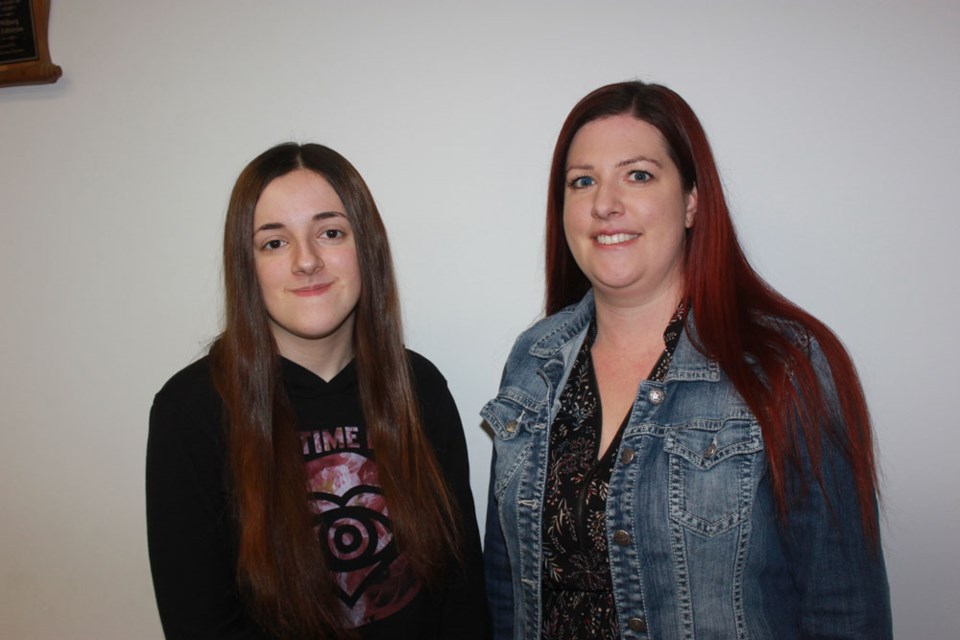It didn’t take long for a local family to find a unique way to benefit from the new 3D printer at the Estevan Public Library.
The library has had the printer for about a month. The technology allows people to create objects to be used for aesthetic or functional purposes.
In the case of Michelle Wilson, it will be used to create prosthetic fingers so her daughter, Brooke, can resume playing the saxophone. Brooke, a 15-year-old student at the Estevan Comprehensive School, was born with syndactyly – a condition that left the fingers on her left hand fused together when she was born.
And while an operation was able to separate the fingers, they are still shorter than those on her right hand, and consequently, too short for her to play the saxophone.
Brooke has a keen interest in music, like a lot of people her age.
“We bought a saxophone last summer,” Michelle Wilson said in an interview with Lifestyles. “She could blow into it. She could do the fingerings with the right hand, and she could make a few notes, but then, when it came time to pressing the octave key with her left thumb, it was just a bit too short, and she wasn’t able to.”
Wilson said they considered creating finger extensions with Lego and medical tape. They hope the prosthetics created with the 3D printer will work, but if it doesn’t, then she said they will try something else.
Three-dimensional printers have been used to create prosthetics in the past. The library shared a story from the Huffington Post last month about a family in the U.S. who used a 3D printer to create a prosthetic left hand for their daughter.
“I was thinking ‘wow, if they can make an entire hand that works and opens and closes, then surely we can make some finger extenders,” said Wilson.
Wilson hopes to create four normal-sized fingers and a thumb for her daughter. They have found designs online from people who have created prosthetic fingers using 3D printers, and Wilson is confident it will work.
“We have to download those plans, customize them to fit her based on her measurements, and email them to the library, and they will print them off,” said Wilson.
At first it seemed to be a complex process for Wilson, who admits she isn’t the most technologically-savvy person. But once they did their research, they realized the process was much easier than they anticipated.
“Designing your own, from the ground up, would be a little more complicated,” said Wilson.
Wilson found out the library possessed the 3D printer technology when she attended a recent art evening at the building. Library branch manager Kate-Lee Nolin presented Wilson with a key chain that was created using a 3D printer.
“My mind was blown by this key chain,” said Wilson. “And then it was a couple days later they linked to the story on the girl … with the prosthetic hand,” said Wilson. “And it has just snowballed since then.”
It could take a couple of weeks to complete the process. The Wilsons will print the designs for one finger and take it to the library. If it is functional, then they will create the other prosthetics.
Brooke has played the trumpet in the past, but now she has braces, and the brass instrument can be tough on her lips. They hope a woodwind instrument like a saxophone will be easier on her mouth.
Wilson noted her daughter has been able to thrive playing the piano despite her shorter fingers on her left hand. And Brooke has thrived playing the guitar in Rock Band, as she scored 96 per cent at the expert level in the video game, so her family bought her a guitar.
She has also played the drums.
Krista Larocque, who is the adult program co-ordinator at the library, noted that when the library first decided to acquire a 3D printer, they were optimistic that patrons would use it to create something to improve their lives.
The request from the Wilsons is the biggest item they have had to date.
“We’ve done just a few projects for people, in regards to things that they want or are looking to design, but nothing like this,” said Larocque.
The printer uses a technology called additive processing, in which it moves layer by layer to create whatever is designed. In the case of the prosthetic fingers, the designs come from websites Thingiverse and Tinkercad.
“Objects that have already been made can be customized to the person who has made it,” said Larocque.
The library’s employees have been training themselves on the 3D printer, so they are more accustomed to the technology.
Larocque is hopeful the library’s new technology will be able to help more people, just like they are optimistic it will be able to assist the Wilsons.
“If you’re using your imagination, and if you’re creating something, then the library wants to be here to help,” said Larocque.




